An Underground Mine Safety-Oriented Optimization Model for Mine Tailings Backfill Scheduling Considering Multi-Process and Multi-Cycle Issues
Abstract
:1. Introduction
- Multifaceted backfilling processes and equipment: The backfilling process comprises a series of intricate steps, including dense tailings, slurry formulation, mixing, and conveying. In each process, cyclones, thickeners, filtration equipment, feeders, mixers, transfer pumps, backfill pipes, and monitoring and control equipment may be used [27,28].
- Diverse slurry composition: The preparation of slurry involves a diverse array of materials, encompassing aggregates, flocculants, cementitious materials, and other additives, such as a water-reducing agent and early strength agent, to achieve the desired properties [29].
- Heterogeneous mining conditions: Distinct mining methods and varying geological conditions across different locations in the mine engender diverse slurry ratios and may necessitate the implementation of distinct preparation processes [30].
- Complex constraints on resources and tasks: The regulation of equipment and resources must comply with operational process constraints, and the applicability, availability, and operational efficiency of resources must also be considered.
2. Tailings Backfill Scheduling
2.1. Mining and Backfilling Operation Cycle and Backfill-Scheduling Objectives
2.2. Backfill Process
2.2.1. Individual Goaf Backfilling Process
2.2.2. Backfill Resources and Classification
- Each backfill unit is equipped to autonomously undertake at least one backfilling process.
- The resources within the backfill unit are categorized into two types: critical resources and supplementary resources.
- Critical resources represent assets that are indispensable for the backfill unit’s operation.
- Supplementary resources possess the capacity to serve multiple backfill units concurrently, and they can support various backfilling processes across multiple goafs.
2.2.3. Multi-Goaf Layered-Backfill Operation Mode
2.3. Essential Aspects in Optimizing Backfill Scheduling
- Holistic attainment of scheduling objectives: The temporal exposure of goafs comprises two distinct segments: the duration from goaf acceptance to backfill initiation, referred to as the backfill delay time, and the actual backfill operation time. By orchestrating the overall backfilling progress from a macroscopic standpoint, and judiciously allotting backfill tasks, the overarching goal lies in curtailing both the backfill delay time and operation duration.
- Interplay constraints between processes and resources: The focus of the optimization model should extend beyond coupling constraints among backfilling processes alone. Equally vital is the consideration of process-continuity requisites. Given the stringent sequence underpinning the process, backfilling operations must remain uninterrupted even in non-emergency circumstances. This prevents gradual slurry condensation within pipelines, limiting the potential for pipeline blockages. Thus, the harmonization of tasks and available resources within intricate operational confines becomes essential for avoiding conflicts between operational tasks and resource utilization.
- Influence of individual-resource disparities: The preparation capacity of slurry is inherently diverse across various equipment types due to factors like construction timelines, equipment models, and operational upkeep. Effective scheduling demands the consideration of individual unit operational capacities, facilitating the judicious allocation of tasks.
- Enhancing operational efficiency: A strategic approach entails the allocation of substantial goafs to units endowed with robust slurry processing capacities, which significantly reduces operational durations. In structuring task schedules, the delicate equilibrium between operational efficiency and task intensity should be artfully navigated.
3. Optimization Model Construction
3.1. Optimization Objective
3.2. Constraints
- (1)
- Earliest available start time constraint:
- (2)
- Process continuity constraint: The process j for goaf i shall begin immediately after the previous process has been completed:
- (3)
- Backfill unit availability constraints
- (4)
- Further simplifications and clarifications
- Upon goaf acceptance, the goaf is ready for backfilling.
- The main backfill network is the mine’s infrastructure. The preparation process focuses on configuring the pipeline from the main line to the goaf.
- The dimensions and proportioning parameters for each layer are determined before backfilling.
- Each goaf is filled and each process is carried out only once.
- All backfill units are accessible at the initial moment.
- Each backfill unit serves one process for a single goaf at the same moment.
- The operation time is computed based on the backfill unit’s daily efficiency.
3.3. Solution Algorithm Design
3.3.1. Coding Strategy
- The sequencing of the backfill processes determines their order.
- The allocation of appropriate backfill units to each process.
3.3.2. GA Solution Process
- Initialization: Define essential parameters for each goaf, loop, flow, and backfill unit and initialize the overarching parameters.
- Initial population: Generate random feasible solutions adhering to the stipulated requirements. For this model, one can expedite optimal solution attainment by setting the initial chromosome’s backfilling initiation time to be as close to the goaf acceptance time as possible.
- Fitness Evaluation: Calculate the fitness value of the population and retain the initial population with the highest fitness value.
- Crossover: Execute crossover operations based on the predetermined crossover probability.
- Mutation: Apply mutations to chromosomes according to a designated probability.
- Fitness Calculation: Determine the fitness of the offspring populations to assess iteration completion. If not reached, merge the selected populations and proceed to step 3. If achieved, proceed to the next step.
- Optimal Solution Analysis: Choose the chromosome with the greatest fitness. Decode and summarize the data to generate data analysis charts.
4. Case and Result Analysis
4.1. Mining and Backfilling Methods
4.2. Slurry Preparation Station Parameters
4.3. Goaf Parameters and Model Inputs
4.4. Model Simulation and Optimization Results
5. Discussion
6. Conclusions
Author Contributions
Funding
Data Availability Statement
Acknowledgments
Conflicts of Interest
Appendix A. Some Abbreviations
| Full Name | Acronym |
| Nondeterministic Polynomial-time hard | NP-hard |
| Genetic Algorithm | GA |
| Preparatory Unit | PU |
| Diversion & Cleaning Unit | D&CU |
| Layered Backfill Unit | LBU |
Appendix B. Result Details
| Goaf | Process | Star Time | End Time | Backfill Unit |
| 1 | 1 | 1.75 | 9.75 | 3 |
| 1 | 2 | 9.75 | 10.5 | 10 |
| 1 | 3 | 10.5 | 16.5 | 8 |
| 1 | 4 | 16.5 | 17.5 | 9 |
| 1 | 5 | 17.5 | 18.5 | 10 |
| 2 | 1 | 0 | 8 | 1 |
| 2 | 2 | 8 | 8.75 | 10 |
| 2 | 3 | 8.75 | 14.75 | 7 |
| 2 | 4 | 14.75 | 15.75 | 7 |
| 2 | 5 | 15.75 | 16.75 | 10 |
| 3 | 1 | 26.75 | 34.75 | 2 |
| 3 | 2 | 34.75 | 35.5 | 10 |
| 3 | 3 | 35.5 | 47.5 | 7 |
| 3 | 4 | 47.5 | 50.5 | 5 |
| 3 | 5 | 50.5 | 51.5 | 10 |
| 4 | 1 | 56 | 64 | 2 |
| 4 | 2 | 64 | 64.75 | 10 |
| 4 | 3 | 64.75 | 77.75 | 6 |
| 4 | 4 | 77.75 | 81.75 | 5 |
| 4 | 5 | 81.75 | 82.75 | 10 |
| 5 | 1 | 72.75 | 80.75 | 2 |
| 5 | 2 | 80.75 | 81.5 | 10 |
| 5 | 3 | 81.5 | 100.5 | 6 |
| 5 | 4 | 100.5 | 105.5 | 5 |
| 5 | 5 | 105.5 | 106.5 | 10 |
| 6 | 1 | 136 | 144 | 3 |
| 6 | 2 | 144 | 144.75 | 10 |
| 6 | 3 | 144.75 | 154.75 | 7 |
| 6 | 4 | 154.75 | 157.75 | 4 |
| 6 | 5 | 157.75 | 158.75 | 10 |
| 7 | 1 | 0.75 | 8.75 | 2 |
| 7 | 2 | 8.75 | 9.5 | 10 |
| 7 | 3 | 9.5 | 41.5 | 4 |
| 7 | 4 | 41.5 | 44.5 | 9 |
| 7 | 5 | 44.5 | 45.5 | 10 |
| 8 | 1 | 11.75 | 19.75 | 1 |
| 8 | 2 | 19.75 | 20.5 | 10 |
| 8 | 3 | 20.5 | 35.5 | 7 |
| 8 | 4 | 35.5 | 38.5 | 9 |
| 8 | 5 | 38.5 | 39.5 | 10 |
| 9 | 1 | 10.5 | 18.5 | 3 |
| 9 | 2 | 18.5 | 19.25 | 10 |
| 9 | 3 | 19.25 | 30.25 | 8 |
| 9 | 4 | 30.25 | 33.25 | 5 |
| 9 | 5 | 33.25 | 34.25 | 10 |
| 10 | 1 | 8.75 | 16.75 | 2 |
| 10 | 2 | 16.75 | 17.5 | 10 |
| 10 | 3 | 17.5 | 33.5 | 9 |
| 10 | 4 | 33.5 | 37.5 | 5 |
| 10 | 5 | 37.5 | 38.5 | 10 |
| 11 | 1 | 24 | 32 | 3 |
| 11 | 2 | 32 | 32.75 | 10 |
| 11 | 3 | 32.75 | 44.75 | 6 |
| 11 | 4 | 44.75 | 46.75 | 9 |
| 11 | 5 | 46.75 | 47.75 | 10 |
| 12 | 1 | 48 | 56 | 2 |
| 12 | 2 | 56 | 56.75 | 10 |
| 12 | 3 | 56.75 | 91.75 | 4 |
| 12 | 4 | 91.75 | 94.75 | 7 |
| 12 | 5 | 94.75 | 95.75 | 10 |
| 13 | 1 | 49.5 | 57.5 | 3 |
| 13 | 2 | 57.5 | 58.25 | 10 |
| 13 | 3 | 58.25 | 63.25 | 6 |
| 13 | 4 | 63.25 | 65.25 | 5 |
| 13 | 5 | 65.25 | 66.25 | 10 |
| 14 | 1 | 48.75 | 56.75 | 1 |
| 14 | 2 | 56.75 | 57.5 | 10 |
| 14 | 3 | 57.5 | 74.5 | 8 |
| 14 | 4 | 74.5 | 77.5 | 8 |
| 14 | 5 | 77.5 | 78.5 | 10 |
| 15 | 1 | 72 | 80 | 3 |
| 15 | 2 | 80 | 80.75 | 10 |
| 15 | 3 | 80.75 | 100.75 | 8 |
| 15 | 4 | 100.75 | 103.75 | 8 |
| 15 | 5 | 103.75 | 104.75 | 10 |
| 16 | 1 | 83 | 91 | 2 |
| 16 | 2 | 91 | 91.75 | 10 |
| 16 | 3 | 91.75 | 130.75 | 4 |
| 16 | 4 | 130.75 | 133.75 | 9 |
| 16 | 5 | 133.75 | 134.75 | 10 |
| 17 | 1 | 98.5 | 106.5 | 3 |
| 17 | 2 | 106.5 | 107.25 | 10 |
| 17 | 3 | 107.25 | 127.25 | 6 |
| 17 | 4 | 127.25 | 130.25 | 6 |
| 17 | 5 | 130.25 | 131.25 | 10 |
| 18 | 1 | 96.75 | 104.75 | 1 |
| 18 | 2 | 104.75 | 105.5 | 10 |
| 18 | 3 | 105.5 | 122.5 | 7 |
| 18 | 4 | 122.5 | 125.5 | 9 |
| 18 | 5 | 125.5 | 126.5 | 10 |
| 19 | 1 | 120.75 | 128.75 | 1 |
| 19 | 2 | 128.75 | 129.5 | 10 |
| 19 | 3 | 129.5 | 135.5 | 8 |
| 19 | 4 | 135.5 | 137.5 | 4 |
| 19 | 5 | 137.5 | 138.5 | 10 |
| 20 | 1 | 128.75 | 136.75 | 1 |
| 20 | 2 | 136.75 | 137.5 | 10 |
| 20 | 3 | 137.5 | 147.5 | 4 |
| 20 | 4 | 147.5 | 148.5 | 9 |
| 20 | 5 | 148.5 | 149.5 | 10 |
| 21 | 1 | 128 | 136 | 2 |
| 21 | 2 | 136 | 136.75 | 10 |
| 21 | 3 | 136.75 | 147.75 | 8 |
| 21 | 4 | 147.75 | 149.75 | 8 |
| 21 | 5 | 149.75 | 150.75 | 10 |
| 22 | 1 | 120 | 128 | 2 |
| 22 | 2 | 128 | 128.75 | 10 |
| 22 | 3 | 128.75 | 144.75 | 7 |
| 22 | 4 | 144.75 | 146.75 | 6 |
| 22 | 5 | 146.75 | 147.75 | 10 |
| 23 | 1 | 144.75 | 152.75 | 1 |
| 23 | 2 | 152.75 | 153.5 | 10 |
| 23 | 3 | 153.5 | 166.5 | 6 |
| 23 | 4 | 166.5 | 168.5 | 7 |
| 23 | 5 | 168.5 | 169.5 | 10 |
| 24 | 1 | 144 | 152 | 3 |
| 24 | 2 | 152 | 152.75 | 10 |
| 24 | 3 | 152.75 | 168.75 | 5 |
| 24 | 4 | 168.75 | 171.75 | 5 |
| 24 | 5 | 171.75 | 172.75 | 10 |
References
- Owen, J.R.; Kemp, D.; Lèbre Svobodova, K.; Pérez Murillo, G. Catastrophic tailings dam failures and disaster risk disclosure. Int. J. Disaster Risk Reduct. 2020, 42, 101361. [Google Scholar] [CrossRef]
- Islam, K.; Murakami, S. Global-scale impact analysis of mine tailings dam failures: 1915–2020. Glob. Environ. Chang. 2021, 70, 102361. [Google Scholar] [CrossRef]
- Rana, N.M.; Ghahramani, N.; Evans, S.G.; Small, A.; Skermer, N.; McDougall, S.; Take, W.A. Global magnitude-frequency statistics of the failures and impacts of large water-retention dams and mine tailings impoundments. Earth-Sci. Rev. 2022, 232, 104144. [Google Scholar] [CrossRef]
- Cacciuttolo, C.; Cano, D. Spatial and Temporal Study of Supernatant Process Water Pond in Tailings Storage Facilities: Use of Remote Sensing Techniques for Preventing Mine Tailings Dam Failures. Sustainability 2023, 15, 4984. [Google Scholar] [CrossRef]
- Cacciuttolo, C.; Atencio, E. Past, Present, and Future of Copper Mine Tailings Governance in Chile (1905–2022): A Review in One of the Leading Mining Countries in the World. Int. J. Environ. Res. Public. Health 2022, 19, 13060. [Google Scholar] [CrossRef] [PubMed]
- Emad, M.Z.; Mitri, H.; Kelly, C. State-of-the-art review of backfill practices for sublevel stoping system. Int. J. Mining Reclam. Environ. 2015, 29, 544–556. [Google Scholar] [CrossRef]
- Sivakugan, N.; Veenstra, R.; Naguleswaran, N. Underground Mine Backfilling in Australia Using Paste Fills and Hydraulic Fills. Int. J. Geosynth. Ground Eng. 2015, 1, 18. [Google Scholar] [CrossRef]
- Benzaazoua, M.; Bussière, B.; Demers, I.; Aubertin, M.; Fried, É.; Blier, A. Integrated mine tailings management by combining environmental desulphurization and cemented paste backfill: Application to mine Doyon, Quebec, Canada. Miner. Eng. 2008, 21, 330–340. [Google Scholar] [CrossRef]
- Sari, M.; Yilmaz, E.; Kasap, T. Long-term ageing characteristics of cemented paste backfill: Usability of sand as a partial substitute of hazardous tailings. J. Clean. Prod. 2023, 401, 136723. [Google Scholar] [CrossRef]
- Yu, H.; Li, S.; Wang, X. The recent progress China has made in the backfill mining method, part I: The theory and equipment of backfill pipeline transportation. Minerals 2021, 11, 1274. [Google Scholar] [CrossRef]
- Yao, Y.; Cui, Z.; Wu, R. Development and challenges on mining backfill technology. Mater. Sci. Res. 2012, 1, 73. [Google Scholar] [CrossRef]
- Cacciuttolo, C.; Marinovic, A. Experiences of Underground Mine Backfilling Using Mine Tailings Developed in the Andean Region of Peru: A Green Mining Solution to Reduce Socio-Environmental Impacts. Sustainability 2023, 15, 12912. [Google Scholar] [CrossRef]
- Stone, D. The evolution of paste for backfill. In Mine Fill 2014: Proceedings of the Eleventh International Symposium on Mining with Backfill; Australian Centre for Geomechanics: Perth, Australia, 2014; pp. 31–33. [Google Scholar]
- Li, S.; Zhao, Z.; Yu, H.; Wang, X. The recent progress China has made in the backfill mining method, Part II: The composition and typical examples of backfill systems. Minerals 2021, 11, 1362. [Google Scholar] [CrossRef]
- Zhao, X.; Fourie, A.; Qi, C. Mechanics and safety issues in tailing-based backfill: A review. Int. J. Min. Met. Mater. 2020, 27, 1165–1178. [Google Scholar] [CrossRef]
- Yin, S.H.; Shao, Y.J.; Wu, A.X.; Wang, H.; Liu, X.; Wang, Y. A systematic review of paste technology in metal mines for cleaner production in China. J. Clean. Prod. 2020, 247, 119590. [Google Scholar] [CrossRef]
- Zhironkin, S.; Gasanov, M.; Suslova, Y. Orderliness in Mining 4.0. Energies 2022, 15, 8153. [Google Scholar] [CrossRef]
- Carrasco, Y. Mining 4.0: A Digital Transformation Approach to Mining Sector. In Proceedings of the Conference “Technology Management and Leadership in Digital Transformation—Looking Ahead to Post-COVID Era”, Portland, OR, USA, 7–11 August 2022; pp. 1–6. [Google Scholar]
- Zhironkina, O.; Zhironkin, S. Technological and Intellectual Transition to Mining 4.0: A Review. Energies 2023, 16, 1427. [Google Scholar] [CrossRef]
- Qi, C.; Fourie, A. Cemented paste backfill for mineral tailings management: Review and future perspectives. Miner. Eng. 2019, 144, 106025. [Google Scholar] [CrossRef]
- Feng, J.; Zhang, Z.; Guan, W.; Wang, W.; Xu, X.; Song, Y.; Liu, H.; Su, H.; Zhao, B.; Hou, D. Review of the Backfill Materials in Chinese Underground Coal Mining. Minerals 2023, 13, 473. [Google Scholar] [CrossRef]
- Xu, C.; Chen, X.; Dai, W. Effects of Digital Transformation on Environmental Governance of Mining Enterprises: Evidence from China. Int. J. Environ. Res. Public. Health 2022, 19, 16474. [Google Scholar] [CrossRef]
- Cacciuttolo, C.; Guzmán, V.; Catriñir, P.; Atencio, E.; Komarizadehasl, S.; Lozano-Galant, J.A. Low-Cost Sensors Technologies for Monitoring Sustainability and Safety Issues in Mining Activities: Advances, Gaps, and Future Directions in the Digitalization for Smart Mining. Sensors 2023, 23, 6846. [Google Scholar] [CrossRef]
- Behera, S.; Mishra, D.; Singh, P.; Mishra, K.; Mandal, S.K.; Ghosh, C.; Kumar, R.; Mandal, P.K. Utilization of mill tailings, fly ash and slag as mine paste backfill material: Review and future perspective. Constr. Build. Mater. 2021, 309, 125120. [Google Scholar] [CrossRef]
- Zhang, X.; Wu, D.; Lu, H.; Liu, L.; Zheng, S. Improvement of tailings gradation on workability and strength of cemented tailings backfill. Constr. Build. Mater. 2023, 387, 131633. [Google Scholar] [CrossRef]
- Liu, L.; Fang, Z.; Qi, C.; Zhang, B.; Guo, L.; Song, K.I. Experimental investigation on the relationship between pore characteristics and unconfined compressive strength of cemented paste backfill. Constr. Build. Mater. 2018, 179, 254–264. [Google Scholar] [CrossRef]
- Belem, T.; Benzaazoua, M. Design and application of underground mine paste backfill technology. Geotech. Geol. Eng. 2008, 26, 147–174. [Google Scholar] [CrossRef]
- Yang, L.; Wang, H.; Wu, A.; Li, H.; Bruno, T.A.; Zhou, X.; Wang, X. Effect of mixing time on hydration kinetics and mechanical property of cemented paste backfill. Constr. Build. Mater. 2018, 247, 118516. [Google Scholar] [CrossRef]
- Panchal, S.; Deb, D.; Sreenivas, T. Mill tailings based composites as paste backfill in mines of U-bearing dolomitic limestone ore. J. Rock. Mech. Geotech. Eng. 2018, 10, 310–322. [Google Scholar] [CrossRef]
- Saedi, A.; Jamshidi-Zanjani, A.; Darban, A.K. A review of additives used in the cemented paste tailings: Environmental aspects and application. J. Environ. Manag. 2021, 289, 112501. [Google Scholar] [CrossRef]
- Wu, A.; Ruan, Z.; Bürger, R.; Yin, S.; Wang, J.; Wang, Y. Optimization of flocculation and settling parameters of tailings slurry by response surface methodology. Miner. Eng. 2020, 156, 106488. [Google Scholar] [CrossRef]
- Walker, W.J.; Montoy, J.; Chatriand, T. Sulfate removal from coalmine water in western Pennsylvania: Regulatory requirements, design, and performance. J. Am. Soc. Min. Reclam. 2015, 4, 73. [Google Scholar]
- Liu, L.; Fang, Z.Y.; Zhang, B.; Wang, M.; Qiu, H.; Zhang, X. Development history and basic categories of mine backfill technology. Met. Mine 2021, 3, 1. [Google Scholar]
- Liu, G.; Li, L.; Yang, X.; Guo, L. A numerical analysis of the stress distribution in backfilled stopes considering nonplanar interfaces between the backfill and rock walls. Int. J. Geotech. Eng. 2016, 10, 271–282. [Google Scholar] [CrossRef]
- Wang, H.; Tenorio, V.; Li, G.; Hou, J.; Hu, N. Optimization of trackless equipment scheduling in underground mines using genetic algorithms. Min. Metall. Explor. 2020, 37, 1531–1544. [Google Scholar] [CrossRef]
- Hou, J.; Li, G.; Wang, H.; Hu, N. Genetic algorithm to simultaneously optimise stope sequencing and equipment dispatching in underground short-term mine planning under time uncertainty. Int. J. Min. Reclam. Environ. 2020, 34, 307–325. [Google Scholar] [CrossRef]
- Wang, H.; Li, G.; Hou, J.; Chen, L.; Hu, N. A path planning method for underground intelligent vehicles based on an improved RRT* algorithm. Electronics 2022, 11, 294. [Google Scholar] [CrossRef]
- Zhou, Y.; Yang, J.J.; Zheng, L.Y. Multi-agent based hyper-heuristics for multi-objective flexible job shop scheduling: A case study in an aero-engine blade manufacturing plant. IEEE Access 2019, 7, 21147–21176. [Google Scholar] [CrossRef]
- Li, J.Q.; Duan, P.; Cao, J.; Lin, X.P.; Han, Y.Y. A hybrid Pareto-based tabu search for the distributed flexible job shop scheduling problem with E/T criteria. IEEE Access 2018, 6, 58883–58897. [Google Scholar] [CrossRef]
- Huang, S.; Li, G.; Ben-Awuah, E.; Afum, B.O.; Hu, N. A robust mixed integer linear programming framework for underground cut-and-fill mining production scheduling. Int. J. Min. Reclam. Environ. 2020, 34, 397–414. [Google Scholar] [CrossRef]
- Cao, S.; Yilmaz, E.; Song, W.; Yilmaz, E.; Xue, G. Loading rate effect on uniaxial compressive strength behavior and acoustic emission properties of cemented tailings backfill. Constr. Build. Mater. 2019, 213, 313–324. [Google Scholar] [CrossRef]
- Yu, H.; Li, S.; Wang, X. The Recent Progress China Has Made in the Backfill Mining Method, Part III: Practical Engineering Problems in Stope and Goaf Backfill. Minerals 2022, 12, 88. [Google Scholar] [CrossRef]
- Liu, Y.; Yang, L.; Wang, S.; Liu, X.; Wang, H.; Li, D.; Wei, P.; Cheng, W.; Chen, B. Origin and Evolution of Ore-Forming Fluid and Gold-Deposition Processes at the Sanshandao Gold Deposit, Jiaodong Peninsula, Eastern China. Minerals 2019, 9, 189. [Google Scholar] [CrossRef]

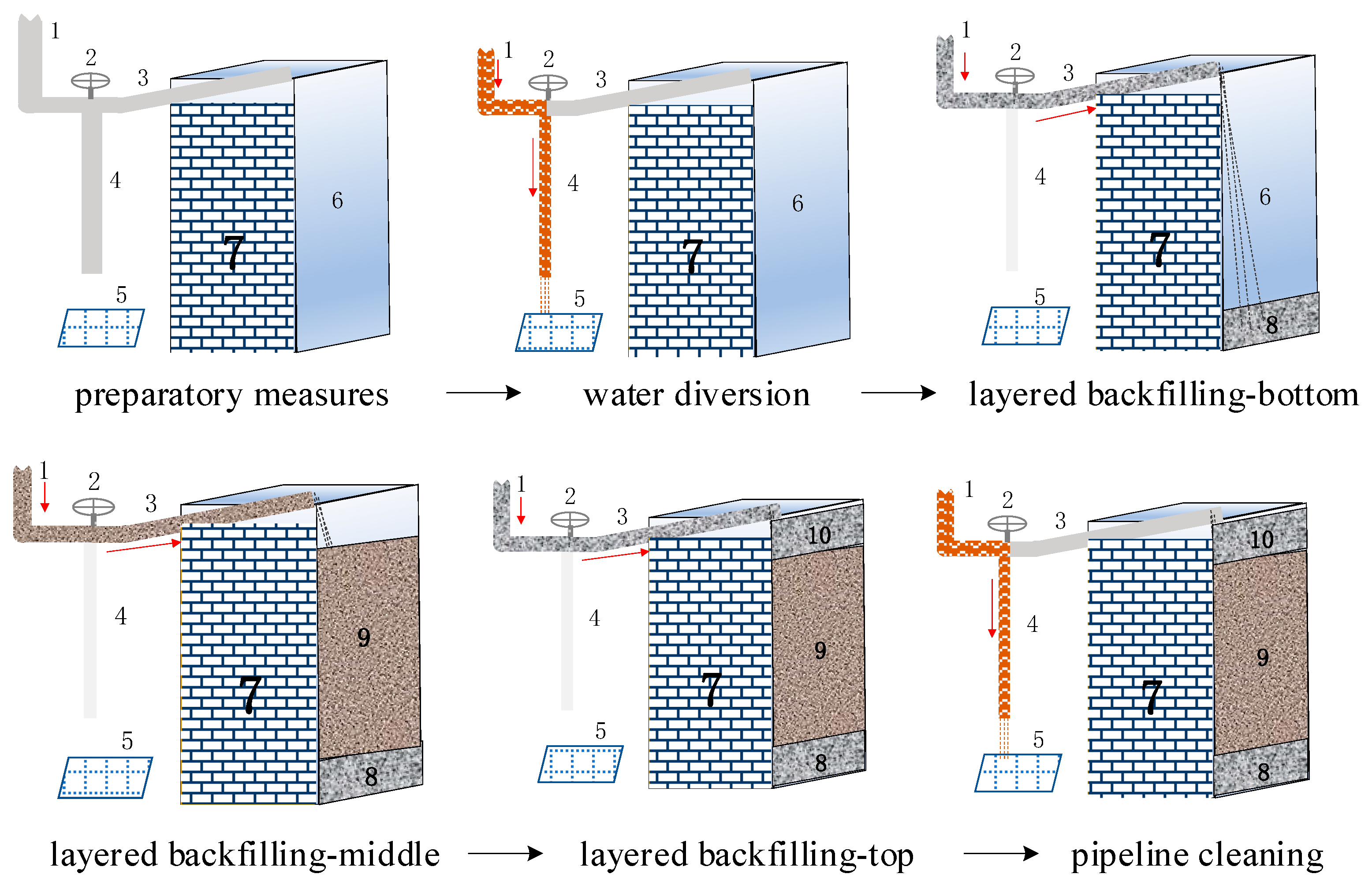
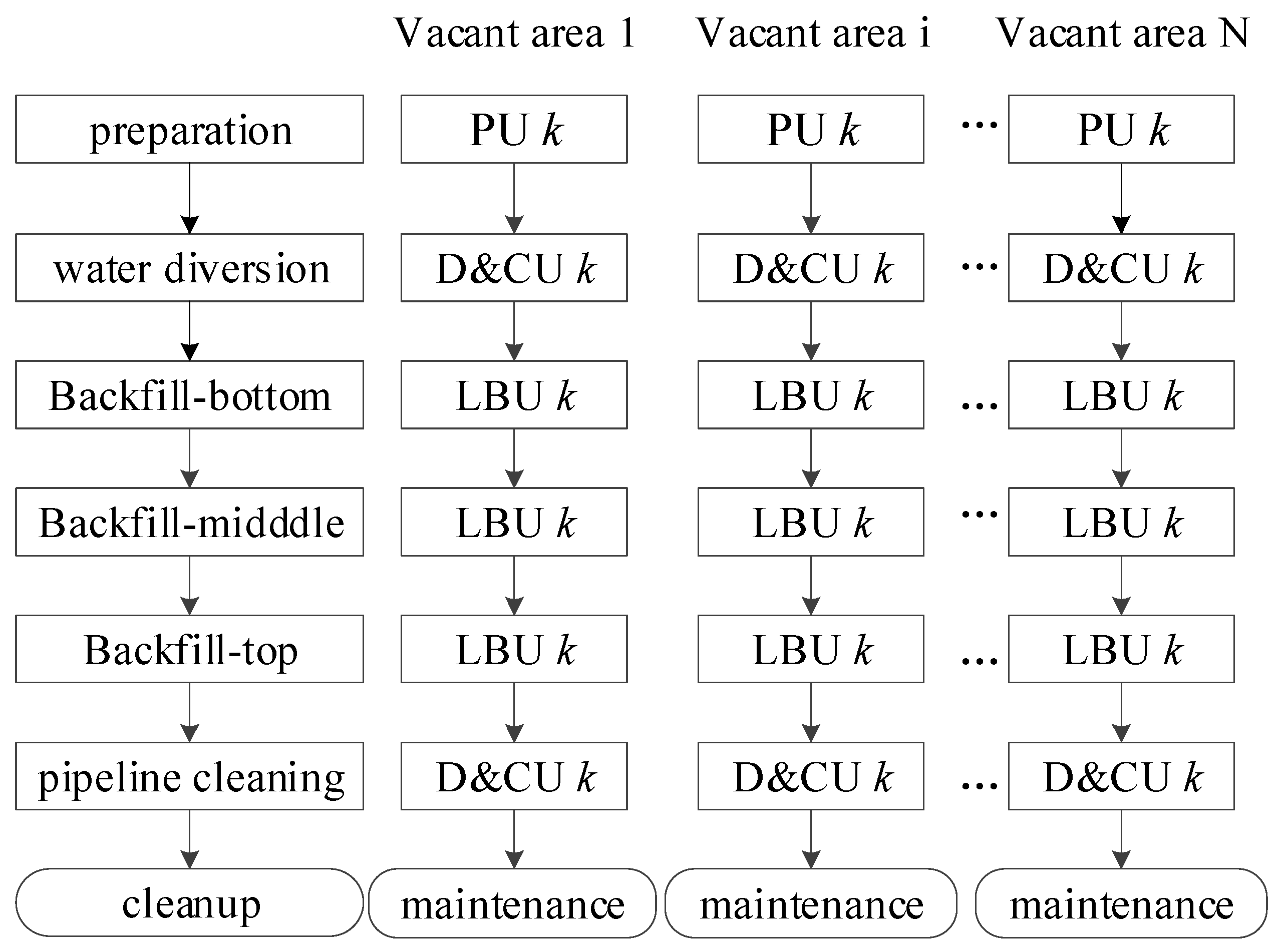

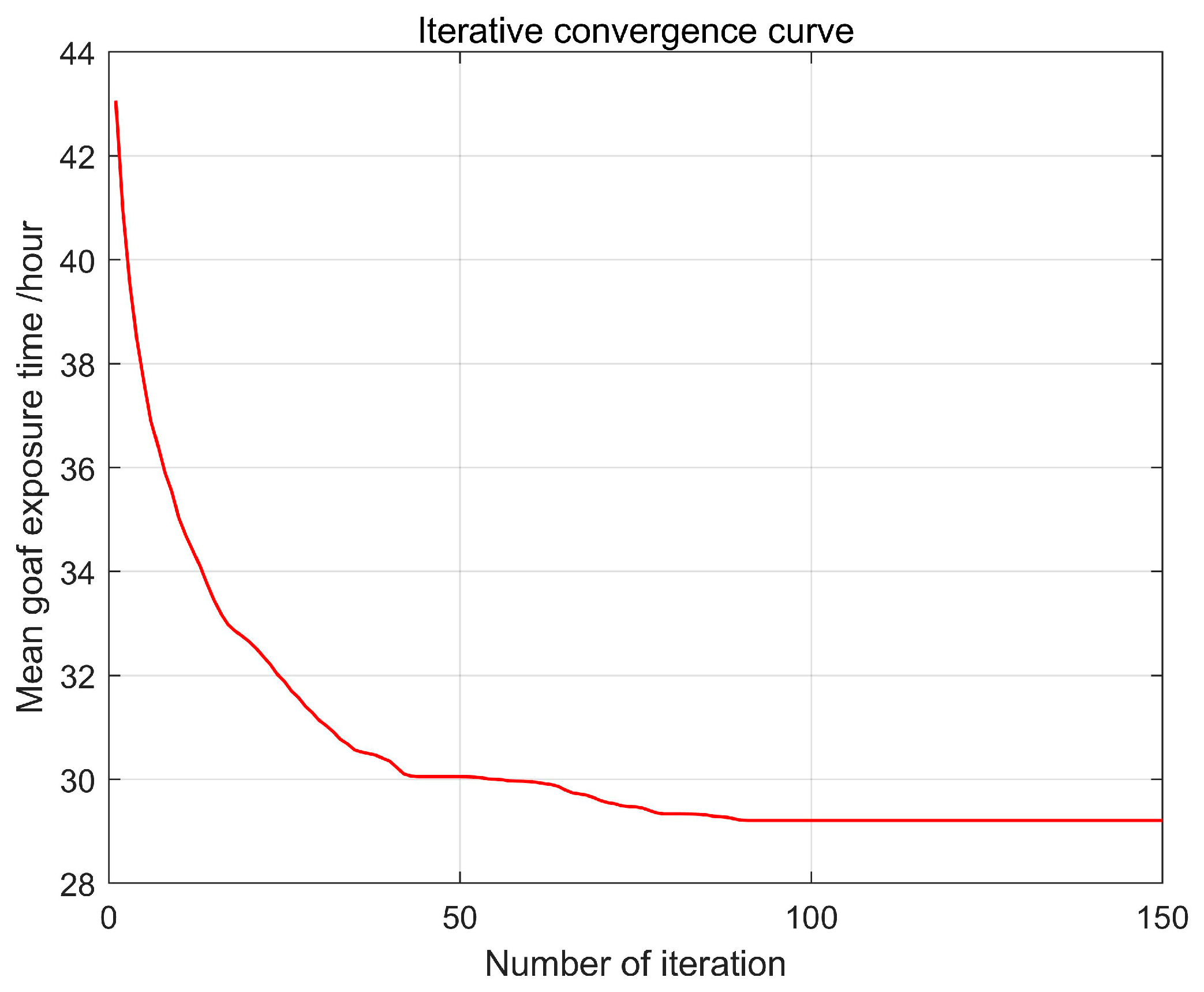
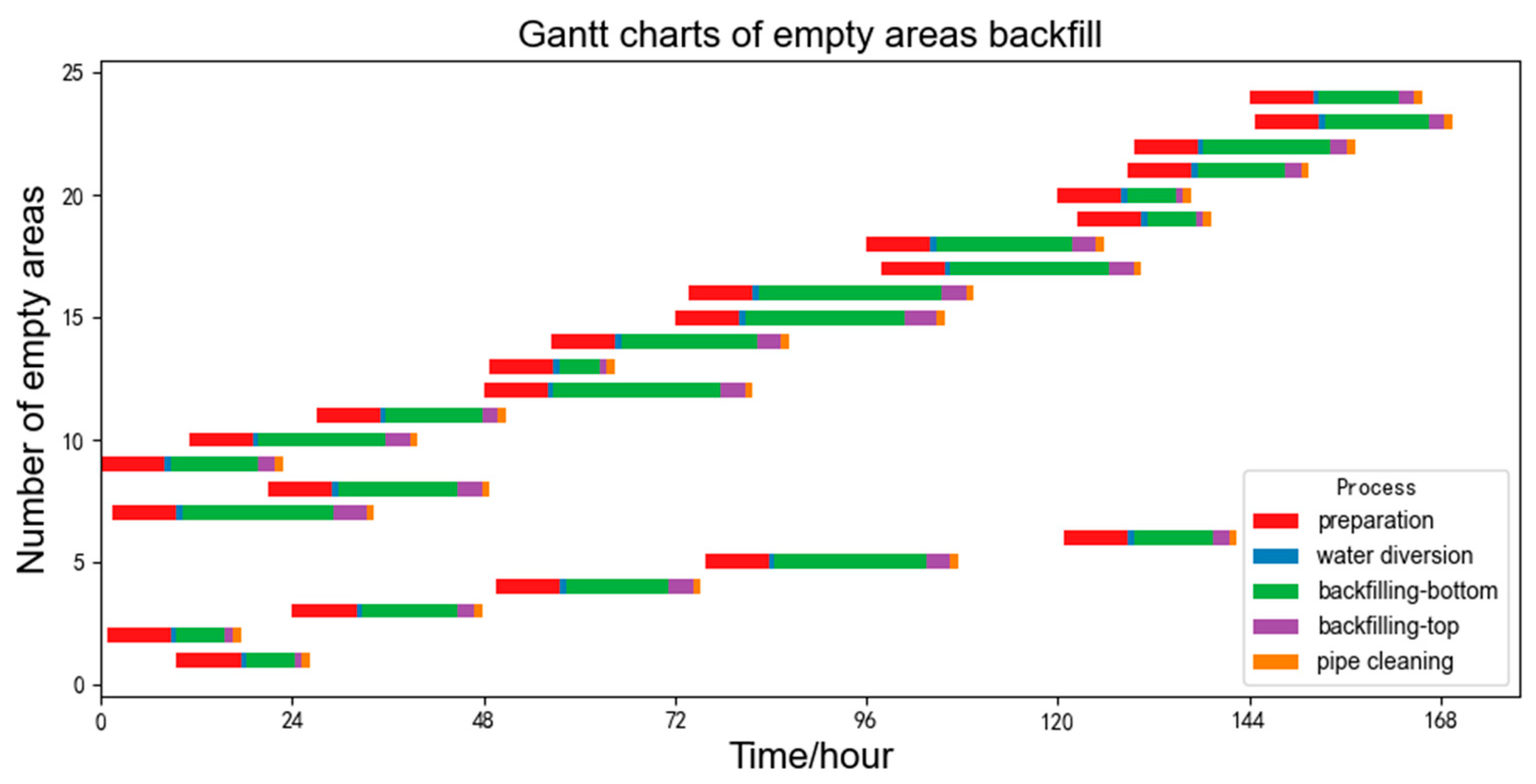
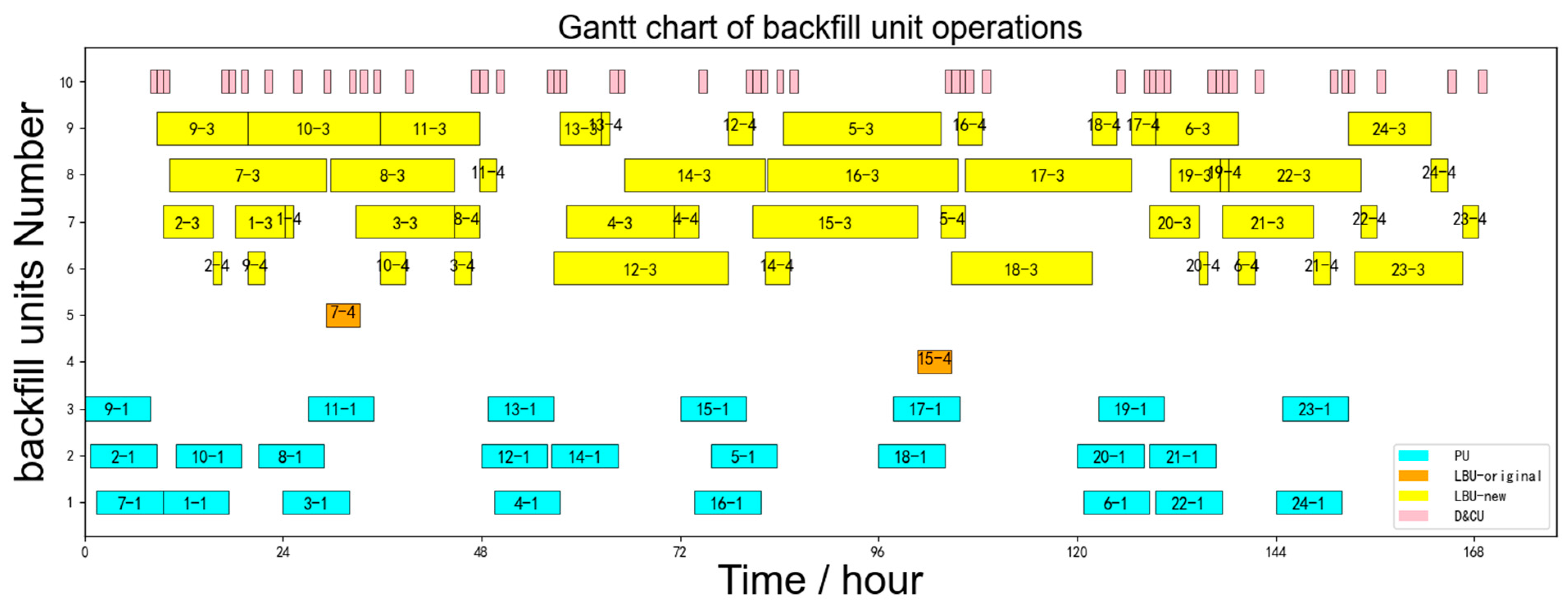
| Business | Equipment |
|---|---|
| aggregate management | Cyclones, flocculant pumps, densifiers, sand silos, feeders, measuring instruments |
| cementitious materials management | Aggregate silos, feeders, metering instruments |
| admixtures management | Additive silos, feeders, metering instruments |
| activation mixing | Mixers, measuring instruments |
| efficient conveying | Transfer tanks, transfer pumps, backfill networks, metering instruments |
| Process | Backfill Unit | Critical Resources | Supplementary Resources |
|---|---|---|---|
| preparation | PU 1 | underground crews 1 | surface crews, efficient conveying |
| PU i | underground crews i | ||
| …PU n | … underground crews n | ||
| water diversion | D&CU 1 … | water tank/pool 1 … | surface crews, efficient conveying, underground crews |
| D&CU n | water tank/pool n | ||
| layered backfilling | LBU 1 | aggregate management 1, activation mixing 1 | surface crews, efficient conveying, underground crews, cementitious materials management, admixtures management, water tank/pool |
| LBU 2 | aggregate management 2, activation mixing 2 | ||
| … LBU n | … aggregate management n, activation mixing n | ||
| pipeline cleaning | D&CU 1 … | water tank/pool 1… | surface crews, efficient conveying, underground crews |
| D&CU n | water tank/pool n |
| Name | Meaning |
|---|---|
| Number of mine goafs within a specified timeframe | |
| Number of backfilling processes per goaf | |
| Number of backfill units | |
| End time of process j in goaf i. i [1, N], j [1, M]/h | |
| Backfilling completion time of goaf i. i [1, N]/h | |
| Backfilling start time of process j in goaf i. i [1, N], j [1, M]/h | |
| Backfilling start time of goaf i. i [1, N]/h | |
| Acceptance time of goaf i. i [1, N]/h | |
| Binary variable, 1 if backfill unit k can serve process j in goaf i, and 0 otherwise. i [1, N], j [1, M], k [1, K] | |
| Time of preparation when using unit k in goaf i, i [1, N], k [1, K]/h | |
| Time of water diversion when using unit k in goaf i, i [1, N], k [1, K]/h | |
| Time of pipeline cleaning when using unit k in goaf i, i [1, N], k [1, K]/h | |
| Time of layered backfilling when using unit k in process j of goaf i. i [1, N], j [1, M], k [1, K]/h | |
| The base of goaf i. i [1, N]/m2 | |
| Layered height in process j of goaf i. i [1, N], j [1, M]/m | |
| Slurry loss coefficient | |
| Setting ratio | |
| Processing capacity of unit k serving process j in goaf i. i [1, N], j [1, M], k [1, K] m3/h | |
| Time of unit k serving process j in goaf i. i [1, N], j [1, M], k [1, K]/h |
| No. | Process | Number of Units | Operating Time (h) |
|---|---|---|---|
| 1 | preparation | 3 | 8 |
| 2 | water diversion | 1 | 0.75 |
| 3 | backfilling-bottom | 6 | calculate |
| 4 | backfilling-top | 6 | calculate |
| 5 | pipe cleaning | 1 | 1 |
| No. | Mine Step | Base (m2) | Height (m) | Acceptance Time (d) | Bottom Slurry Volume (m3) | Top Slurry Volume (m3) |
|---|---|---|---|---|---|---|
| 1 | 2 | 213.4 | 2.59 | 1 | 539.05 | 98.59 |
| 2 | 2 | 149.4 | 3.36 | 1 | 510.42 | 69.02 |
| 3 | 2 | 266.86 | 4.23 | 2 | 1179.88 | 123.29 |
| 4 | 2 | 501.2 | 2.5 | 3 | 1215.66 | 231.55 |
| 5 | 2 | 538.8 | 3.3 | 4 | 1804.71 | 248.93 |
| 6 | 2 | 330.6 | 2.8 | 6 | 916.42 | 152.74 |
| 7 | 1 | 498.6 | 3.67 | 1 | 1881.41 | 230.35 |
| 8 | 1 | 467.1 | 3.07 | 1 | 1438.85 | 215.80 |
| 9 | 1 | 286.2 | 3.44 | 1 | 1003.91 | 132.22 |
| 10 | 1 | 438.33 | 3.45 | 1 | 1544.13 | 202.51 |
| 11 | 1 | 418.07 | 2.81 | 2 | 1163.72 | 193.15 |
| 12 | 1 | 556.3 | 3.61 | 3 | 2059.30 | 257.01 |
| 13 | 1 | 135.5 | 3.4 | 3 | 469.51 | 62.60 |
| 14 | 1 | 500 | 3.2 | 3 | 1617.00 | 231.00 |
| 15 | 1 | 505.9 | 3.78 | 4 | 1974.98 | 233.73 |
| 16 | 1 | 471 | 4.6 | 4 | 2284.82 | 217.60 |
| 17 | 1 | 477.4 | 3.9 | 5 | 1930.99 | 220.56 |
| 18 | 1 | 438 | 3.6 | 5 | 1618.85 | 202.36 |
| 19 | 1 | 173.44 | 3.04 | 6 | 528.85 | 80.13 |
| 20 | 1 | 169.43 | 3.22 | 6 | 551.85 | 78.28 |
| 21 | 1 | 305.4 | 3.34 | 6 | 1036.34 | 141.09 |
| 22 | 1 | 360.2 | 4.18 | 6 | 1574.26 | 166.41 |
| 23 | 1 | 340.2 | 3.61 | 7 | 1260.52 | 157.17 |
| 24 | 1 | 360.8 | 2.64 | 7 | 933.05 | 166.69 |
| Indicator | Traditional | Optimization | Enhancement Ratio |
|---|---|---|---|
| Goafs’ exposure time/h | 874.75 | 701 | 19.86% |
| operating time/h | 675 | 614 | 9.04% |
| Average delay/h | 8.32 | 3.625 | 56.4% |
Disclaimer/Publisher’s Note: The statements, opinions and data contained in all publications are solely those of the individual author(s) and contributor(s) and not of MDPI and/or the editor(s). MDPI and/or the editor(s) disclaim responsibility for any injury to people or property resulting from any ideas, methods, instructions or products referred to in the content. |
© 2023 by the authors. Licensee MDPI, Basel, Switzerland. This article is an open access article distributed under the terms and conditions of the Creative Commons Attribution (CC BY) license (https://creativecommons.org/licenses/by/4.0/).
Share and Cite
Liu, Y.; Li, G.; Hou, J.; Guo, G.; Pan, D.; Yu, Q. An Underground Mine Safety-Oriented Optimization Model for Mine Tailings Backfill Scheduling Considering Multi-Process and Multi-Cycle Issues. Minerals 2023, 13, 1409. https://doi.org/10.3390/min13111409
Liu Y, Li G, Hou J, Guo G, Pan D, Yu Q. An Underground Mine Safety-Oriented Optimization Model for Mine Tailings Backfill Scheduling Considering Multi-Process and Multi-Cycle Issues. Minerals. 2023; 13(11):1409. https://doi.org/10.3390/min13111409
Chicago/Turabian StyleLiu, Yuhang, Guoqing Li, Jie Hou, Guangjun Guo, Dong Pan, and Qianqian Yu. 2023. "An Underground Mine Safety-Oriented Optimization Model for Mine Tailings Backfill Scheduling Considering Multi-Process and Multi-Cycle Issues" Minerals 13, no. 11: 1409. https://doi.org/10.3390/min13111409
APA StyleLiu, Y., Li, G., Hou, J., Guo, G., Pan, D., & Yu, Q. (2023). An Underground Mine Safety-Oriented Optimization Model for Mine Tailings Backfill Scheduling Considering Multi-Process and Multi-Cycle Issues. Minerals, 13(11), 1409. https://doi.org/10.3390/min13111409






